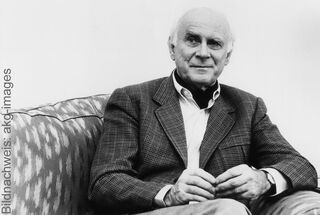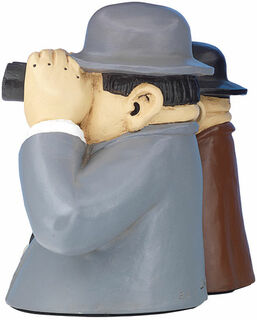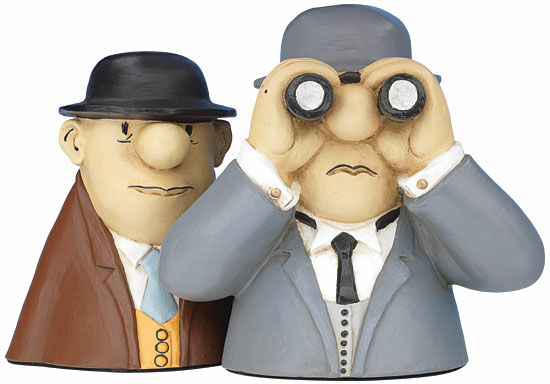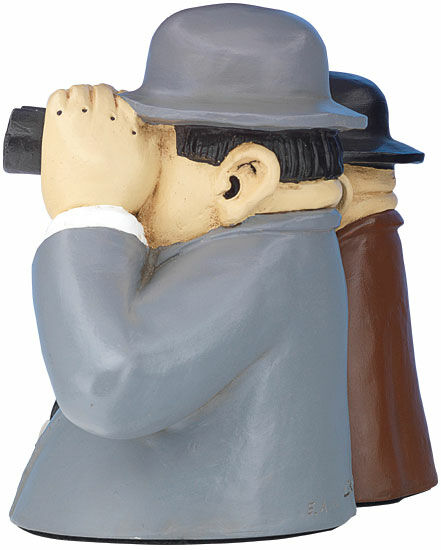Sculpture "Gentlemen at the Racetrack", cast version
Sculpture "Gentlemen at the Racetrack", cast version
Quick info
ars mundi Exclusive Edition | limited, 1,499 copies | numbered | signed | certificate | edition in cast | hand-painted | size 16 x 25 x 10.5 cm (h/w/d) | weight 2.8 kg
Detailed description
Sculpture "Gentlemen at the Racetrack", cast version
Exclusive to ars mundi: Loriot's sketch as a sculpture.
The comedic genius Loriot also had role models, and sometimes he paid homage to them with his works: "At the Racecourse", for example, is the film version of a radio sketch that deals with the communicative clash between self-proclaimed "experts" and ignorant "amateurs". The original author was the comedian Wilhelm Bendow, who recorded his text for the first time in 1926 with Paul Morgan and then again in 1946 with Franz-Otto Krüger.
This later live radio recording delivered the sketch into more recent times and was re-released on record in the early 1970s. However, it was only through Loriot's animated drawings that it became known to a large audience. One quote from the sketch has long since surpassed the status of a catchphrase and has become a cult phrase since it was first broadcast on television. The phrase "Wo laufen sie denn?" (Where are they running?) is remembered across the generations for Bendow's inimitable voice and Loriot's sensitive, graphic rendering of both characters.
Loriot, the "grand seigneur" of German humour, was blessed with numerous talents. He was a clever observer who mischievously quietly laughed to himself while opening our eyes to the absurdity of everyday life situations. That is also the case for the sketch "At the Racecourse", which he adapted. Each of the words written by Bendow could have been written by Loriot. Because the consequences of failed communication between two people who are not even malicious but merely caught up in a narrow perspective, status pretensions or are just ignorant were just as readily and repeatedly elaborated by Loriot. His theme was the phenomenon of misunderstanding and the resulting consequences. German people could identify with all these sometimes dogged, bizarre, but always amiable characters without being offended. On the contrary, they loved Loriot because he observed them so closely.
Sculpture "Gentlemen at the Racecourse":
Edition in hand-painted cast. Limited edition of 1,499 copies, numbered and signed by Loriot, a numbered certificate is enclosed. Size 16 x 25 x 10.5 cm (h/w/d). Weight 2.8 kg. ars mundi Exclusive Edition.
Customer reviews

About Loriot
1923-2011, a german draughtsman, cartoonist, author, humourist, opera director
He won several german "golden" awards: two Golden Cameras, two Golden Records, the Golden Screen, the Golden Gramophone and the Golden Lion of Honour. Not to mention the Ernst Lubitsch and Adolph Grimme prizes, the Telestar or the Sonderbambi... He was awarded the Order of Merit of the Federal Republic of Germany for his special services.
Loriot is best known for his cartoons and sketches with the characters feature of bulbous noses. For example, two popular characters are Mr Müller-Lüdenscheid and Dr Klöbner, who - unawares - get into the same hotel bathtub and argue so delightful about whether the rubber duck should be allowed in the water or not... In his books, Loriot has dealt intensively with the passage of time. "Loriot's Diary - Zeitgeschehen von Meisterhand" or "Loriot's Heile Welt - Neue gesammelte Texte und Zeichnungen zu brennenden Fragen der Zeit" are just two out of many examples.
Vicco von Bülow, alias Loriot, was without a doubt the "grand seigneur" of German humour. His sketches are often known by heart by a lot of people and no matter the art he was creating - whether as a caricaturist, a humourist, an actor or director - he always achieved something special and memorable.
"Comedy, as I understand it, always deals with self-irony, otherwise something is missing. You have to include yourself." This is the secret to his success and noticeable in all his works. That‘s why his humour is never disparaging, never hurtful. Loriot was always extremely tender even with the characters in his most accurate parodies and precisely observed exposures of middle-class narrow-mindedness. Loriot’s humour, one could say, is not a sharp dagger for grim confrontations, but a fine scalpel that ultimately works towards healing the world with every cut.
The "grand seigneur" of German humour died in August 2011.
Graphic or sculpture edition that was initiated by ars mundi and is available only at ars mundi or at distribution partners licensed by ars mundi.
Collective term for all casting processes that ars mundi carries out with the help of specialised art foundries.
Stone casting
Similar to artificial marble, with the difference that the substitute stone in powder form is used instead of marble powder.
Bonded Bronze (Cold-Cast-Bronze)
Bronze powder is polymer-bonded. Special polishing and patination techniques give the surface of the casting an appearance similar to the bronze.
Imitation Wood
In order to guarantee absolute fidelity to the original, an artificially manufactured imitation wood is used as a base material that features typical wood characteristics: density, workability, colour and surface structure.
Ceramic Mould Casting
Ceramic mould casting usually requires the use of casting clay, which is then fired and optionally glazed. Instead of the usual rubber moulds, plaster moulds are often used in ceramic casting and porcelain production.
Cast Bronze (Lost-Wax Casting)
For the cast bronze, the thousand-year-old lost-wax technique is used. It's the best, but also the most complex method of producing sculptures.
Term for an art object (sculpture, installation), which is produced in multiple copies in a limited and numbered edition according to the artist‘s will.
Artist's multiples have been called the most accessible and affordable art on the market.
A plastic work of sculptural art made of wood, stone, ivory, bronze or other metals.
While sculptures from wood, ivory or stone are made directly from the block of material, in bronze casting a working model is prepared at first. Usually, it is made of clay or other easily mouldable materials.
The prime time of sculpture after the Greek and Roman antiquity was the Renaissance. Impressionism gave a new impulse to the sculptural arts. Contemporary artists such as Jorg Immendorf, Andora, and Markus Lupertz also enriched sculptures with outstanding works.












